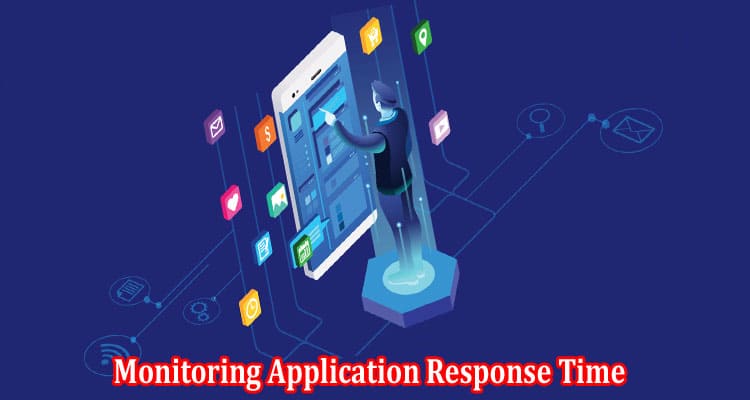Definition and Importance
Application response time monitoring systematically measures and evaluates the time it takes for a software application to respond to user requests or perform specific tasks. It involves tracking and analyzing the delay between a user’s input and the application’s output. This critical aspect of performance monitoring provides insights into software systems’ overall efficiency and health, identifying potential bottlenecks, slowdowns, or issues that may impact user experience. Special tools and techniques collect response time data for proactive troubleshooting, optimization, and maintenance of user experiences. Monitoring application response times ensures software applications meet performance expectations and deliver a smooth and responsive user interface.
What types of issues or bottlenecks can negatively impact application response times?
Several issues and bottlenecks can negatively impact application response times, leading to slow or unresponsive user experiences. These issues can occur at various levels of an application’s architecture. Here are some common factors that can degrade response times:
- High Server Load: When application servers are overloaded with requests, response times slow as the server struggles to keep up with processing incoming requests.
- Inefficient Code: Poorly optimized or inefficient code can lead to longer execution times for operations, including database queries, calculations, or data processing.
- Database Performance: Slow database queries, inefficient indexing, and many concurrent database connections can result in delays as the application waits for data retrieval and updates.
- Network Latency: Latency in network connections between the user’s device and the application server can cause delays in transmitting data, resulting in slower response times.
- Inadequate Server Resources: A lack of server resources, such as CPU, memory, or disk space, can lead to resource contention and degraded performance.
- Third-Party Services: Dependency on external services, such as APIs or third-party integrations, can introduce response time variability, especially if these services experience downtime or performance issues.
- Application Architecture: Poorly designed application architecture, including the choice of frameworks and components, can lead to bottlenecks and performance limitations.
- Caching Issues: Ineffective or misconfigured caching mechanisms can prevent the application from quickly delivering cached content, leading to slower response times.
- Large Media Files: Heavy media files, such as images and videos, can significantly impact page load times, especially on mobile applications with limited bandwidth.
- Traffic Spikes: Sudden surges in user traffic, such as during promotional events or marketing campaigns, can overwhelm servers and lead to slower response times.
- Concurrency and Locking: In multi-user applications, concurrent access and database locking issues can cause contention and delay response times.
- Geographic Location: The physical location of the application server relative to the users can influence response times, with longer distances resulting in increased latency.
How to improve application response time?
Improving application response time is crucial for delivering a better user experience and ensuring your application remains competitive. Here are some effective strategies to enhance application response times:
Code Optimization:
- Identify and optimize inefficient code, including algorithms, database queries, and resource usage.
- Minimize the use of nested loops and heavy computations.
Database Performance:
- Optimize database queries by using proper indexing, limiting the use of SELECT *, and reducing redundant data retrieval.
- Consider denormalization for frequently accessed data.
- Utilize caching mechanisms to reduce the load on the database.
Caching:
- Implement caching at various levels (e.g., object caching, page caching, and content delivery network caching) to serve frequently accessed content faster.
- Use browser caching to store static assets on the user’s device.
Content Compression:
- Compress text-based resources like HTML, CSS, and JavaScript to reduce bandwidth usage and improve page load times.
Parallel Processing:
- Utilize multi-threading or parallel processing to handle multiple requests simultaneously, reducing user response times.
Load Balancing:
- Distribute incoming traffic evenly across multiple servers using load balancers to prevent overload and ensure consistent performance.
Content Delivery Network (CDN):
- Implement a CDN to serve static content from geographically distributed servers, reducing latency and improving delivery times.
Minimize Third-Party Dependencies:
- Limit the use of third-party scripts and services to reduce the impact of external dependencies on response times.
Mobile Optimization:
- Optimize design and content for mobile to improve user experience and load times.
Reduce HTTP Requests:
- Combine and minify CSS and JavaScript files to reduce the number of HTTP requests.
- Use sprites for small images.
Asynchronous Loading:
- Implement asynchronous loading of non-essential resources to ensure critical content loads quickly.
Content Lazy Loading:
- Use lazy loading techniques to load images and content only when they become visible to the user.
Content Prioritization:
- Prioritize the loading of essential content above the fold to provide a faster-perceived response time to users.
Optimize Images and Multimedia:
- Image compression and optimization are excellent methods for reducing file size while keeping image quality.
- Use the appropriate multimedia formats and codecs.
Content Delivery Optimization:
- Implement server-side optimizations, such as GZIP compression, to reduce the size of content transferred to the user’s device.
Progressive Web Apps (PWAs):
- Develop applications as PWAs, allowing users to access content even in low network conditions and providing a more responsive experience.
Browser Caching:
- Utilize HTTP caching headers to instruct browsers to cache resources, reducing the need to reload them on subsequent visits.
Content Preloading:
- Use resource hints and preloading to initiate the retrieval of critical resources before they are needed.
Content Delivery Strategy:
- Evaluate using a content delivery strategy that delivers content from the nearest data center or edge location to the user.
Regular Monitoring and Testing:
- Continuously monitor application performance using APM tools and conduct load testing to identify bottlenecks and areas for improvement.
Improving application response time is an ongoing process that requires regular monitoring, testing, and optimization efforts.
Which tools or software solutions are commonly employed to monitor application response times?
Monitoring application response times is critical to ensuring a smooth and efficient user experience. To achieve this, mobile app development companies often employ various tools and software solutions designed to track, analyze, and optimize the time their applications take to respond to user inputs or requests. These tools and solutions help identify potential issues, bottlenecks, or areas for improvement in an app’s performance.
Some of the commonly used tools and software solutions for monitoring application response times include:
Application Performance Monitoring (APM) Solutions: APM solutions are comprehensive tools that offer a holistic view of an app’s performance. They collect data on various aspects, including server response times, database performance, and user experience. Powered by AI and machine learning, APM solutions can proactively detect issues, making them indispensable for mobile app development companies aiming to maintain high-quality performance.
Real User Monitoring (RUM) Tools: RUM tools track the experience of real users interacting with the application. They capture data on response times, page load times, and user interactions. Examples include Google Analytics, Pingdom Real User Monitoring, and New Relic Browser.
Synthetic Monitoring Tools: Synthetic monitoring tools simulate user interactions with the application by sending predefined artificial requests regularly. They help evaluate application response times from different geographic locations. Examples include Uptime Robot, Pingdom, and Catchpoint.
Load Testing: In load testing, developers simulate various user scenarios and traffic levels, enabling them to assess the app’s performance under different conditions, prepare for peak usage, and ensure consistent response times.
Performance Profiling: This technique involves a detailed analysis of an app’s performance in real-world scenarios. It helps developers pinpoint areas that consume excessive resources or hinder response times, allowing for targeted optimization.
Database Performance Monitoring Tools: These tools focus on monitoring the performance of database queries and operations, which can significantly impact application response times. Examples include QuerySurge, VividCortex, and SQL Diagnostic Manager for SQL Server.
Network Performance Monitoring Tools: Network monitoring tools like Wireshark and Nagios can help diagnose and address network-related issues affecting application response times.
Cloud-Based Monitoring Services: Cloud-based monitoring services like AWS CloudWatch, Azure Application Insights, and Google Cloud Monitoring provide specific insights into applications deployed on cloud platforms.
Open-Source Monitoring Solutions: Open-source options like Prometheus and Grafana can be customized to monitor application response times and other performance metrics.
Web Performance Testing Tools: Tools like WebPageTest and Google PageSpeed Insights help measure web pages’ response times and assess their performance.
If you’re looking for Monitoring Application Response Times services, Octa Consulting, a leading Mobile App Development company in New York, tailors its tool and solution selection to meet your application’s unique needs, technology stack, and monitoring objectives. Octa Consulting may utilize a blend of tools to provide a comprehensive overview of application response times and overall performance, guaranteeing top-notch functionality for their clients.




